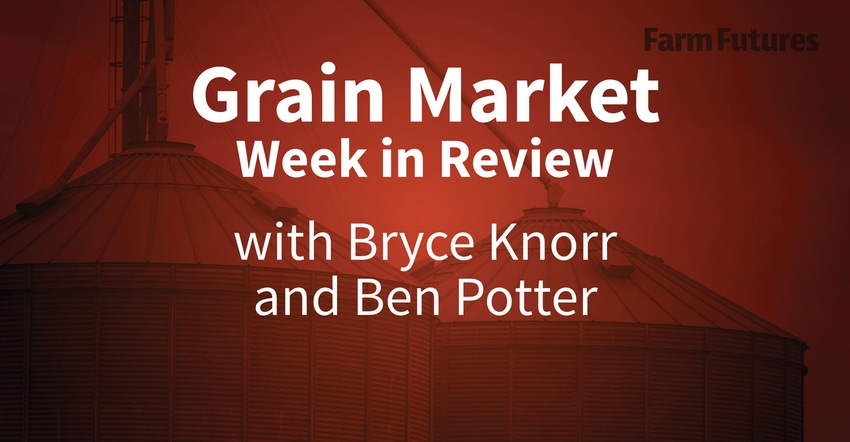October 4, 2019

Missed some market news this week? Here’s what Bryce Knorr and Ben Potter have been writing about.
Audio
Grain markets moved higher overnight as traders make final bets before USDA reports due out at 11 a.m. CST. The government updates Sept. 1 inventories and also releases another estimate of wheat production. The marketing-year-end estimates for corn and soybeans sometimes produce surprises, with potential for the 2018 soybean crop to be smaller than previously reported. Weather continues to deteriorate on the northern Plains, making today’s estimate of spring wheat production closely watched as well.
More selling on stock exchanges around the world sent money fleeing from many markets overnight including commodities. After spiking higher in the wake of USDA reports Monday, lack of news about exports or weather threats put futures back on their heels. Corn and soybeans consolidated gains while wheat stumbled at chart resistance.
Grain futures are lower this morning with markets of all stripes playing a waiting game. Crop prices could hinge on developments next week, including a USDA report out Thursday followed Friday morning by the first serious threat of frost. Wall Street won’t have to wait that long for direction. Jobs numbers for September due out at 7:30 a.m. CDT are expected to be weak, reflecting a series of negative economic reports out earlier in the week.
Crop progress
As September comes to a close, more areas are experiencing way too much rain, adding insult to injury. The northwest quarter of the Midwest and Plains saw above normal precipitation for the month, with some areas of the northern Plains receiving six times the average amount. All the moisture delayed spring wheat harvest, raising concerns about both quality and quantity, sparking a sharp rally by Minneapolis futures.
With a wet, cool spring that featured an abundance of late-planted crops, it’s perhaps no surprise that the 2019 harvest is also off to a sluggish start. Corn harvest reached 11% completion as of Sept. 29. The 2019 soybean harvest is off and running, with 7% now complete.
Exports
Were soybean export inspections “good” or “bad” this past week? That question typically has a subjective answer – especially in the latest round of grain export inspection data from USDA, out Monday morning.
Soybean export sales doubled for the week ending September 26, but grain markets nonetheless shrugged off that bullish bit of data from USDA’s latest export report, out Thursday morning.
Market recaps
Grain futures are mostly a little lower this morning but hovering around chart support levels as a quiet overnight session winds down. In addition to updated USDA supply and demand estimates next week, corn and soybeans in the northwest Corn Belt face a serious threat for cold enough weather to end the growing season.
Grain prices faced few big moves Friday, with corn taking moderate losses while soybeans gathered modest gains. Wheat finished the session mixed but mostly higher. Fall weather is finally upon us, with cooler-than-normal temperatures likely through at least the middle of next week, with the danger of frost and snow lurking in some northern portions of the Midwest and Plains.
Special reports
Grain futures moved sharply higher following bullish Sept. 1 stocks data for corn and soybeans and lower wheat production. USDA put Sept. 1 corn carryout at 2.114 billion bushels, 331 million below its last estimate Sept. 12. USDA cut the 2018 soybean production estimate by 116 million bushels. USDA had mixed news for wheat.
Outlooks
Basis outlook - While combines are rolling this fall, the slow pace bringing in 2019 corn and soybeans continues to limit weakness in the cash market. Changes in basis as a result were more a matter of demand, with some unusual changes seen. Corn bids in the eastern Corn Belt remains above average after a series of poor crops. Soybean bids strengthened a penny or two, boosted by good export demand that firmed the tone all along the river system.
Fertilizer outlook - Fall has begun, and with it the seasonal trend towards higher fertilizer prices. But an uncertain outlook and a later than normal harvest make it difficult to predict how much costs will increase – or in some cases, whether they’ll increase at all.
Corn outlook - All right all you farmers who think USDA only puts out bearish data in the government’s never-ending quest to put you out of business. You’ve got to admit the agency’s estimate of Sept. 1 corn inventories was a pleasant surprise.
Soybean outlook - Most of the discussion in the soybean market over the past year focused on demand and rightly so. Losing your biggest customer generally isn’t a good business model. But the reduction in Sept. 1 supplies reported by USDA is turning the discussion back to supply as growers start to harvest a 2019 soybean crop that’s run the gauntlet.
Wheat outlook - Wheat, more than most markets, seems to be driven by technical trading. That’s looking more like the case as all three markets ran into chart resistance and fell apart after a rally fueled by some big gains in Minneapolis. Buying stopped when USDA failed to confirm trouble with the spring wheat crop despite soggy conditions that slowed harvest and raised concerns about quality. Even a big early season snow storm in Montana couldn’t keep the trajectory going.
About the Author(s)
You May Also Like




